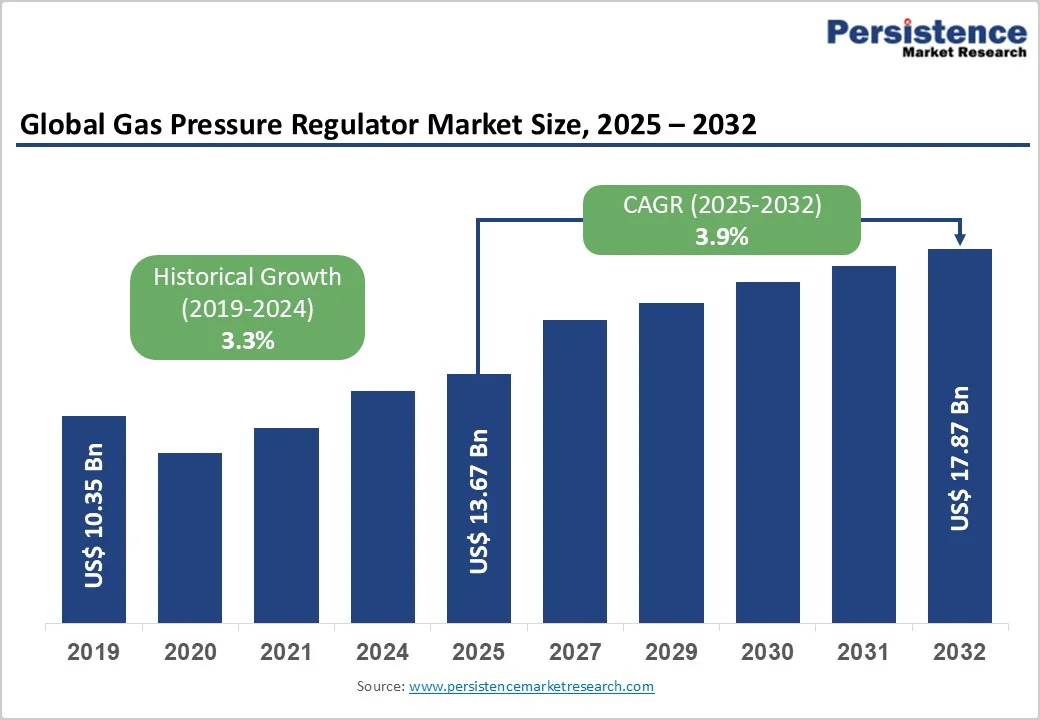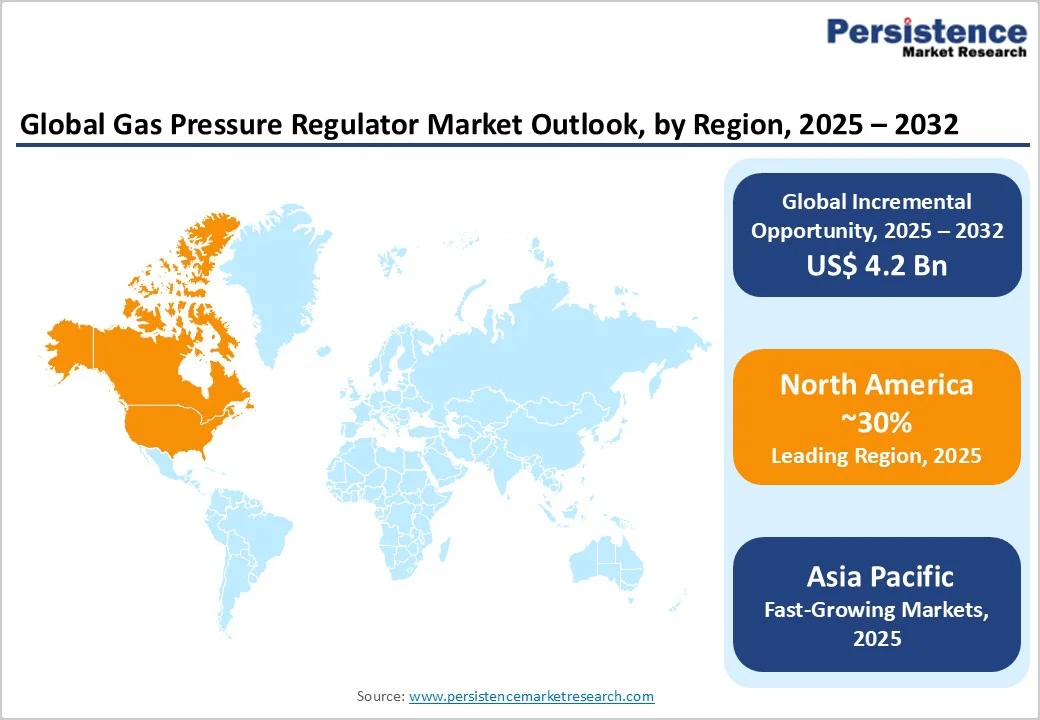ID: PMRREP18322| 260 Pages | 14 Nov 2025 | Format: PDF, Excel, PPT* | Industrial Automation

The global gas pressure regulator market size is likely to be valued at US$13.67 billion in 2025 and is projected to reach US$17.87 billion by 2032, growing at a CAGR of 3.9% between 2025 and 2032. The demand grows due to investments in new gas infrastructure, expanding industrial base in Asia-Pacific, and regulatory requirements for process safety. Key growth enablers include technological innovation, uptake across healthcare and water treatment, and transition to low-carbon energy sources.
| Key Insights | Details |
|---|---|
| Gas Pressure Regulator Market Size (2025E) | US$ 13.67 Bn |
| Projected Market Value (2032F) | US$ 17.87 Bn |
| Global Market Growth Rate (CAGR 2025 to 2032) | 3.9% |
| Historical Market Growth Rate (CAGR 2019 to 2023) | 3.3% |

Global urbanization and industrialization directly increase the need for safe, reliable gas distribution. In 2025, more than 45% of total installations were attributed to new factories and urban projects, notably in China, India, and Southeast Asia. Regulatory mandates established by agencies—including the U.S. Department of Energy (DOE) and China's National Development and Reform Commission—require advanced gas pressure regulators in all new energy and utility development projects, effectively driving year-over-year growth.
International efforts to reduce emissions propel natural gas and LPG adoption, with OECD and IEA-backed policies supporting cleaner fuel infrastructure. In 2024, the EU’s “Green Gas Support Scheme” and India’s LPG expansion program contributed to greater market penetration. Approximately 53% of new residential energy connections now utilize regulated natural gas, underscoring sustained demand for pressure management solutions.
Technological progress—in AI-driven diagnostics, IoT-enabled remote monitoring, and smart sensors—has transformed reliability and responsiveness. By 2025, nearly 37% of new market entrants will have launched products equipped for digital integration and real-time leak/fault detection. Such features are crucial for compliance in hazardous environments and medical gas delivery.
Advanced regulator systems, especially those with smart features, entail considerable initial investment and require specialized installation skills. The shortage of trained technicians and engineers in emerging markets impedes adoption, particularly in rural and small enterprise sectors, resulting in slower rate of technology penetration and higher maintenance costs.
Aged pipeline infrastructure in mature markets poses retrofitting challenges, increasing project costs and complicating compliance with diverse international standards. Retrofits of legacy networks in North America and Europe can inflate regulator system costs by up to 15-20%, influencing replacement cycles and leading to delays in large municipal upgrades.
Fast-growth is expected in the high-pressure segment and for hydrogen-ready devices as new industries (green hydrogen plants, refueling stations) come online. Investments and subsidies are driving a 6.2% CAGR in these segments, which represent actionable opportunities for product differentiation and market capture.
Asia Pacific accounts for more than 39% of gas regulator installations, with rapid deployment in both urban residential and clustered industrial parks. Local governments grant incentives for LPG/CNG conversion, smart metering, and modular pressure control systems—representing scalable opportunity for manufacturers.
The healthcare segment posts a 5.1% CAGR, spurred by hospital expansions and regulatory standards for medical gas supply. Smart homes increasingly require pressure regulators integrated with home automation, driving new product launches into mainstream consumer electronics and utilities markets.
Low-pressure regulators dominate the market, capturing a 37.3% share in 2025. Their core role is safe home, commercial kitchen, and utility gas delivery. Large-scale adoption is supported by ongoing replacement cycles and regulatory incentives for new builds; resilience and user-friendliness ensure steady volume growth.
High-pressure regulators are the fastest growing segment, reflecting demand for industrial, energy plant, and hydrogen applications. This segment benefits from the expansion of manufacturing and chemical plants using gases under high pressure. Growth is anticipated at over 6.2% CAGR, with industry stakeholders investing in R&D to optimize regulator design for hydrogen and other specialty gases.[2][1]
Brass Regulators
Brass regulators are the market share leaders, accounting for 34.1% in 2025. Preferred for their strength, corrosion resistance, and broad applicability in industrial and residential systems, brass remains the standard in multi-gas supply pipelines and utility connections.
Stainless steel, as the fastest growing material segment, is driven by stringent safety and hygiene requirements in healthcare, pharmaceuticals, and chemical manufacturing. Enhanced durability and expanded compatibility push CAGR in this segment above the industry average, notably for clean-room and critical environment installations.
End-use Analysis
Industrial manufacturing represents the largest end-use category, claiming a 45.3% share in 2025. With factories and process industries depending upon controlled gas supply for operational and occupational safety, manufacturers are scaling up regulator installations for diverse production lines.
Healthcare is the fastest growing end-use segment, with a CAGR of 5.1%. The requirement for precise pressure management in oxygen delivery, anesthesia, and laboratory gases is augmented by post-pandemic infrastructure investment and regulatory updates, especially across Southeast Asia and Europe.

North America is the market leader, attributed to advanced gas distribution network maturity and strict implementation of safety standards (e.g., ANSI Z21, OSHA regulations). The U.S. occupies over 21.3% of global market share, propelled by ongoing infrastructure upgrades, residential conversions to gas heating, and strong industrial output. Canada and Mexico are also experiencing growth, albeit from a smaller base, aided by cross-border regulatory harmonization and trade in gas equipment. Investment in hydrogen blending pilots and smart regulator deployment further underpin future expansion. The region’s competitive landscape is marked by highly consolidated supply chains, with major manufacturers such as Emerson and Honeywell spearheading innovation.
Europe follows North America in market size, led by Germany, France, the UK, and Spain. The region’s driving forces are government mandates on energy transition, national incentives for upgrading natural gas grids, and phasing out legacy boilers for hydrogen-ready systems. Germany’s Energiewende program and EU-wide sustainability goals stimulate demand for high-performance, eco-friendly regulators. The healthcare segment is robust, and modular designs for industrial SMEs (small and medium-sized enterprises) are gaining traction. Regulatory advances ensure strong compliance and facilitate transnational market presence, especially in high-value end markets.
Asia Pacific emerges as the fastest growing region, responsible for more than 39% of installations in 2025. China, India, Japan, and ASEAN economies benefit from rapid urbanization, aggressive government incentives for LPG/CNG conversion, and new industrial cluster developments. Growth in smart cities, infrastructure expansion, and robust water treatment investments contribute to record regulator unit installations. The competitive landscape is fragmented, with global leaders focusing on strategic partnerships and local manufacturing to address regulator customization preferences and regulatory diversity.

The Gas Pressure Regulator Market is moderately consolidated, with the top five player Emerson Electric, The Linde Group, Air Liquide, Cavagna Group, and Itron Inc. accounting for about 60-65% of global revenue. The remainder is split among regional specialists and niche market entrants. Leading companies maintain strong competitive positioning via product innovation, comprehensive service contracts, and investment in digital integration. Smaller and new entrants are increasing market fragmentation in selected Asia Pacific and European countries.
Recent Industry Developments:
The Gas Pressure Regulator market is estimated to be valued at US$ 13.67 Bn in 2025.
The key demand driver for the Gas Pressure Regulator market is the rising need for precise pressure control and safety in industrial, energy, and healthcare applications.
In 2025, the North America region will dominate the market with an exceeding 30% revenue share in the global Gas Pressure Regulator market.
Among the Pressure Range, Low Pressure (0-20 psi) hold the highest preference, capturing beyond 37.3% of the market revenue share in 2025, surpassing other products.
The key players in the Gas Pressure Regulator market are Kennametal Inc., Flow International Corporation, OMAX Corporation, CERATIZIT S.A. and GMA Garnet Pty. Ltd.
| Report Attribute | Details |
|---|---|
| Historical Data/Actuals | 2019 – 2024 |
| Forecast Period | 2025 – 2032 |
| Market Analysis Units | Value: US$ Bn, Volume: Units |
| Geographical Coverage |
|
| Segmental Coverage |
|
| Competitive Analysis |
|
| Report Highlights |
|
By Pressure Range
By Material
By Product Type
By End-use
By Region
Delivery Timelines
For more information on this report and its delivery timelines please get in touch with our sales team.
About Author